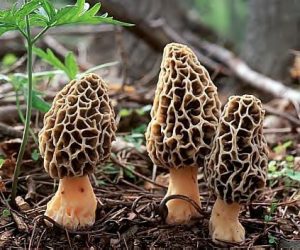Foraged food is growing in popularity. And safety is a concern.
A couple of months ago, Marcus Plescia, director of the Mecklenburg County Health Department told Kathleen Purvis of the Charlotte Observer, ‘We want restaurants to be creative and experimental. We also want them to be safe. There’s got to be somebody who can make sure the restaurants that want to do foraging are doing so in a safe way.”
Stuff like wild-grown mushrooms, ramps and game carry different risks because they aren’t in a managed system or environment. Misidentify a mushroom and a customer can die.
Hunting morels are big business and many of the foraged fungi end up in restaurants sold on somewhat of a black market. According to NPR some national forests, a favorite spot for foragers after controlled burnings, are not happy about the amateur food harvesters.
Usually, the U.S. Forest Service offers a special license to pick morels for commercial use in burn zones. But this year, managers in Montana decided not to issue any commercial licenses. In fact, it’s illegal to pick in burn zones in any of Montana’s National Forests. The ban is sending pickers like Zaitz underground.
The problem isn’t over-picking, says Deb Mucklow, a district ranger for the Flathead National Forest, it’s the hordes of people who show up to pick. She says the last time the Flathead forest had big fires in 2007, hundreds of people came the next summer to pick morels. They left behind a huge mess.
“We had issues with litter, with the latrines,” says Mucklow.
Pickers came from all over the country, including crews of migrant pickers from Cambodia, Laos and Mexico. There were even rumors that some of the pickers were trying to pay off gambling debts with mushroom money. Things got dangerously territorial in the backcountry.
“People were using firearms or side arms to say ‘this is my area, nobody can go into it,’ ” says Mucklow.
So this season, the Forest Service decided to only issue personal-use permits, which limit a picker to 60 gallons for the entire season. It also requires pickers to cut their mushrooms in half so they can’t sell them.
For some local pickers, the ban has been a huge financial hit.
“It really put us in a difficult position,” says Renee, who lives in Kalispell, Mont. NPR agreed not to use her last name because she is breaking the law by continuing to sell her mushrooms.
Every year Renee and her husband supplement their income by selling morels. They both have regular day jobs — she’s a house cleaner, he’s a handyman. They hoped selling morels would bring in enough income for the first and last month’s rent on a new apartment.
In the past, Renee sold her morels to chefs at restaurants or from the back of her truck for $20 a pound. This year, she’s hesitant to sell so openly and she’s only making half of what she normally does.
“We don’t want to get in any trouble, we certainly don’t want to get our buyers into any trouble,” she says. “We try to sell them under the radar, but it’s been very difficult.”
Renee sells on Facebook in what’s become something like a mushroom black market. She feels the Forest Service is making her into a criminal for something she’s done legally for years.
